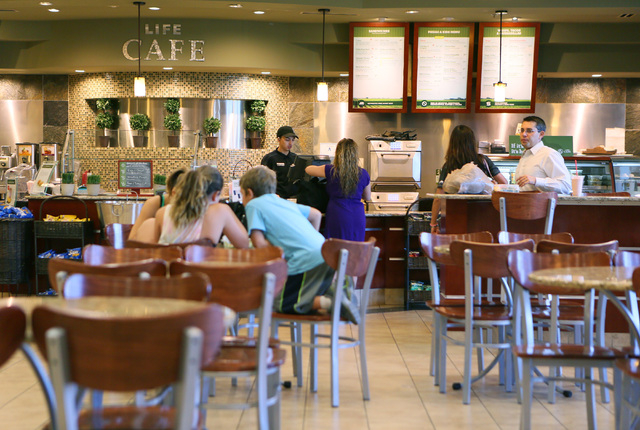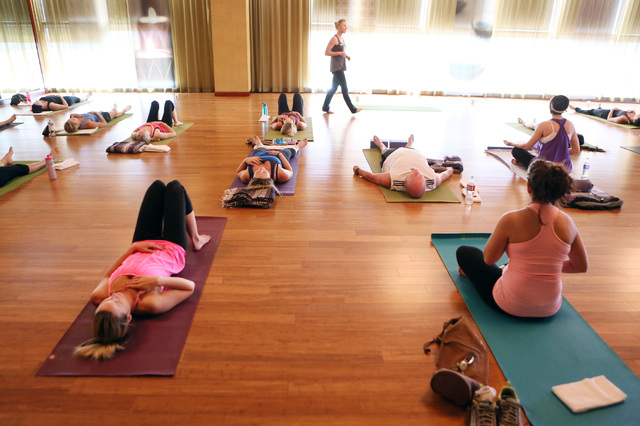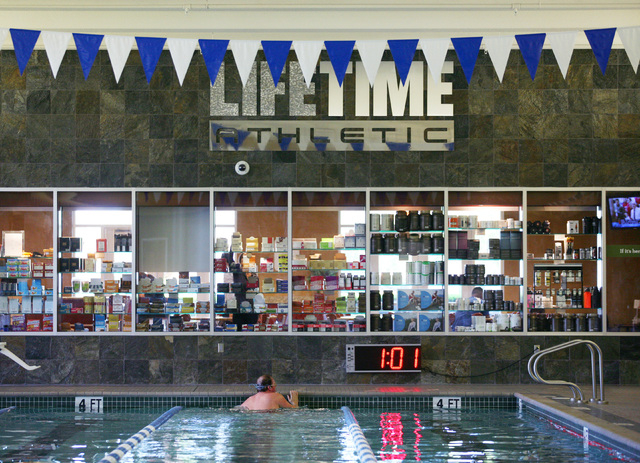Vegas fitness industry is bulking up
The health club industry slimmed down in the recession.
But with unemployment falling and the housing market rising, the sector is bulking up again. It doesn’t hurt that projections call for sustained growth as the population ages and companies show more interest in wellness.
Industry observers say trends look especially strong in Las Vegas, where long-term population gains and an expanding economy have given health clubs the nod to renew building.
“We’ve looked at the market as a whole, and the indicators and conditions that we see are really strong,” said Jeff Zweifel, chief operating officer of Life Time Fitness, which is building its second local club. Life Time Athletics is operated by Life Time Fitness.
Added Bret Fitzgerald, vice president of corporate communications for Las Vegas Athletic Clubs: “The growth of the city is really the key to our growth. As the city expands out in all directions, we’re going to grow as well. And the population is aging. More people are understanding the benefits of staying active, so that’s good for us.”
NOT COASTING
The recession touched pretty much every corner of the economy, and fitness clubs were no exception. Industry revenue nationwide shrank from $24.1 billion in 2008 to $23.7 billion in 2009, according to a report from market research firm IBISWorld. Membership also dipped, from 45.5 million to 45.3 million.
Local clubs wouldn’t disclose specific membership trends, but they all felt the fallout. “People who had work for 20 years were all of a sudden getting laid off,” Fitzgerald said.
With broad economic improvements, though, health clubs are getting stronger. Fitness clubs membership had climbed back to more than 50 million by 2012, and the industry will ring up $26.5 billion in revenue this year, IBISWorld said. Annual industry growth from 2014 to 2019 will average 2.8 percent, up from 2.3 percent from 2009 to 2014.
What’s spurring expansion? More baby boomers signing up to stay fit, as well as a jump in disposable income and a growing emphasis among insurers and employers on tackling obesity.
Not everyone is feeling the gains equally. Clubs that have fared best are at the high and low ends of the membership-fee spectrum.
Consider Life Time, where single memberships start at $140 a month and family memberships begin at $290, on top of a one-time initiation fee of $100 to $200. Life Time opened its first local club in Summerlin in 2011, smack in the middle of the city’s housing bust and unemployment crisis. Rather than swooning amid difficult conditions, the company built waiting lists for its facilities, including for the club under construction in Green Valley. Its preview center opened July 1 at 121 Carnegie Drive, and the club is scheduled to open in the fourth quarter. Nationally, Life Time’s revenue jumped 11.2 percent from 2011 to 2012, to $1.1 billion, according to a report from the Boston-based International Health, Racquet and Sportsclub Association.
Dwelling at the high end has allowed Life Time to take a “more integrated and holistic approach,” Zweifel said. “It’s a much broader approach to a healthy way of life” that includes everything from children’s academies and team sports to rock-climbing walls and leisure pools. There’s also a social element in Life Time’s spas and cafes, he said.
Less expensive are Las Vegas Athletic Clubs, with a basic membership fee of $23 a month. The six-club chain has grown its average-daily-workout count from 20,000 pre-recession to 22,000 today, Fitzgerald said. It’s building a seventh area club — and its first in North Las Vegas — on Decatur Boulevard south of the 215 Beltway.
“North Las Vegas was devastated by foreclosures, but it stabilized, and a lot of the properties that were vacant have been purchased or rented out,” Fitzgerald said. “The amount of homes that now have occupancy has increased significantly since 2010 and 2011, and now, we see it as a fertile place to open a club. There are residents there, and businesses are growing.”
Las Vegas Athletic Clubs officials are eyeing land in Henderson for a bigger facility to replace a 22-year-old, 30,000-square-foot club at Flamingo and Sandhill roads.
“The price reality of our gym makes it a lot easier to say, ‘OK, I’m gonna give this a try,’ ” Fitzgerald said of the company’s growth. “We’re a Nordstrom-type club at Wal-Mart prices. Life Time is a Nordstrom-type club at Nordstrom prices.”
The midmarket has had fewer new members, and has struggled as a result. Industry-heavy 24 Hour Fitness, with local membership rates in the $40s, went on the auction block in 2012, only to be taken off of the market in 2013 after offers came in too low. Plus, midmarket franchise operations have cut branches. Curves, once a fast-growing chain with a $45 monthly fee, closed half of its U.S. locations, shrinking from 8,000 in 2005 to about 4,000 in 2011. Southern Nevada locations fell by more than half.
CHANGING HABITS
Although much of the carnage was recession-related, some traced to the changing nature of consumers’ fitness habits. Studios dedicated to specialties such as CrossFit or yoga have nibbled away at membership for mainstream clubs. The emergence of seriously low-priced operators such as Planet Fitness, where monthly fees start at $10, has also affected the sector.
“The industry has fragmented more, and that fragmentation really created a strong separation between the low-end, price-driven operations and the high end,” Zweifel said. “The operators that have been participating at that midpriced point of $29 to $59 a month on single membership dues have absolutely been getting crushed.”
Survival has required adapting.
Life Time is focusing on “filet mignon” sites in upscale suburbs, and the company has become “much more clear and deliberate about the customers we’re looking to go after,” Zweifel said. “We’re not looking to be everything to all people.”
The emphasis is on cultivating frequent repeat users. Life Time doesn’t just have a basketball court. It has an “Ultimate Hoops” program that trains participants for local league play. Its run-club members don’t just jog on treadmills. They prepare for 5K and 10K races, Zweifel said.
“Everything comes back to making sure our customer experience is at the highest level,” he said.
For Las Vegas Athletic Clubs, thriving has meant muscling up new gyms. The North Las Vegas branch will weigh in at 85,000 square feet, compared with a companywide average of 65,000. It will have two swimming pools, a sauna, at least two group-fitness rooms and an indoor running track. Its 700 parking spaces will trounce the industry average of 100 to 300 stalls.
Also, the surging popularity of CrossFit — a weight-lifting workout that uses peer pressure to push participants to work harder — is shaping the club’s offerings. Ten to 15 percent of consumers “want something very intense,” Fitzgerald said, so his company has a “nice portfolio” of high-intensity group-fitness classes, such as boot camps and kickboxing.
Given population forecasts, Las Vegas Athletic Clubs could see itself grow to 10 area locations, Fitzgerald said. Beyond that, it might branch out into other regions.
“We’re excited about the future. We think Las Vegas still needs to get out of a little bit of the doldrums, but it’s happening, and we’re seeing it because our membership sales and retention have been pretty fabulous over the last couple of years.”
Contact reporter Jennifer Robison at jrobison@reviewjournal.com. Follow @J_Robison1 on Twitter.






















